Comparative Genomics and Adaptive Evolution of Bifidobacterium adolescentis in Geographically Distinct Human Gut Populations
Abstract
1. Introduction
2. Materials and Methods
2.1. Strain Activation Culture
2.2. Genome Sequencing and Assembly of Strains
2.3. The Average Nucleotide Identity (ANI) Value Analysis
2.4. Pan-Genome and Core-Genome Analysis and Phylogenetic Analyses
2.5. Carbohydrate Activity Enzyme (CAZy) Analysis
2.6. Cluster of Orthologous Group (COG) Annotation
2.7. Prediction of Bacteriocin Manipulators
2.8. AntiSMASH Predictive Analysis
2.9. CRISPR Identification
2.10. Data Visualization and Statistics
3. Results
3.1. Genomic Features of B. adolescentis Isolates
3.2. ANI Values of B. adolescentis
3.3. Pan–Core Genome of B. adolescentis
3.4. The Phylogenetic Tree of B. adolescentis
3.5. Annotation of Carbohydrate Enzyme in B. adolescentis
3.6. Annotation of COG in B. adolescentis
3.7. Annotation of Bacteriocin Operon in B. adolescentis
3.8. AntiSMASH Predictive Analysis by B. adolescentis
3.9. Identification of CRISPR-Cas Systemn in B. adolescentis
4. Discussion
5. Conclusions
Supplementary Materials
Author Contributions
Funding
Data Availability Statement
Conflicts of Interest
Abbreviations
| CAZys | carbohydrate-active enzymes |
| GOSs | galactooligosaccharides |
| NA | niacin |
| ANI | average nucleotide identity |
| NJ | Neighbor-Joining |
| COG | Cluster of Orthologous Groups |
| CDS | predicted number of coding sequences |
| GHs | glycoside hydrolases |
| GTs | glycosyltransferases |
| CBMs | carbohydrate-binding modules |
| CEs | carbohydrate esterases |
| NRPs | nonribosomal peptides |
References
- Gutierrez, A.; Pucket, B.; Engevik, M.A. Bifidobacterium and the intestinal mucus layer. Microbiome Res. Rep. 2023, 2, 36. [Google Scholar] [CrossRef]
- Sivan, A.; Corrales, L.; Hubert, N.; Williams, J.B.; Aquino-Michaels, K.; Earley, Z.M.; Benyamin, F.W.; Lei, Y.M.; Jabri, B.; Alegre, M.-L.; et al. Commensal Bifidobacterium promotes antitumor immunity and facilitates anti–PD-L1 efficacy. Science 2015, 350, 1084–1089. [Google Scholar] [CrossRef]
- Turroni, F.; Milani, C.; Ventura, M.; van Sinderen, D. The human gut microbiota during the initial stages of life: Insights from bifidobacteria. Curr. Opin. Biotechnol. 2022, 73, 81–87. [Google Scholar] [CrossRef]
- Barzegari, A.; Kheyrolahzadeh, K.; Hosseiniyan Khatibi, S.M.; Sharifi, S.; Memar, M.Y.; Zununi Vahed, S. The Battle of Probiotics and Their Derivatives Against Biofilms. Infect. Drug Resist. 2020, 13, 659–672. [Google Scholar] [CrossRef]
- Arboleya, S.; Watkins, C.; Stanton, C.; Ross, R.P. Gut Bifidobacteria Populations in Human Health and Aging. Front. Microbiol. 2016, 7, 1204. [Google Scholar] [CrossRef] [PubMed]
- Kawabata, K.; Baba, N.; Sakano, T.; Hamano, Y.; Taira, S.; Tamura, A.; Baba, S.; Natsume, M.; Ishii, T.; Murakami, S.; et al. Functional properties of anti-inflammatory substances from quercetin-treated Bifidobacterium adolescentis. Biosci. Biotechnol. Biochem. 2018, 82, 689–697. [Google Scholar] [CrossRef]
- Yang, J.; Tang, Q.; Xu, L.; Li, Z.; Ma, Y.; Yao, D. Combining of transcriptome and metabolome analyses for understanding the utilization and metabolic pathways of Xylo-oligosaccharide in Bifidobacterium adolescentis ATCC 15703. Food Sci. Nutr. 2019, 7, 3480–3493. [Google Scholar] [CrossRef] [PubMed]
- Krumbeck, J.A.; Maldonado-Gomez, M.X.; Martínez, I.; Frese, S.A.; Burkey, T.E.; Rasineni, K.; Ramer-Tait, A.E.; Harris, E.N.; Hutkins, R.W.; Walter, J.; et al. In Vivo Selection To Identify Bacterial Strains with Enhanced Ecological Performance in Synbiotic Applications. Appl. Environ. Microbiol. 2015, 81, 2455–2465. [Google Scholar] [CrossRef]
- Rudjito, R.C.; Jiménez-Quero, A.; Muñoz, M.D.C.C.; Kuil, T.; Olsson, L.; Stringer, M.A.; Krogh, K.B.R.M.; Eklöf, J.; Vilaplana, F. Arabinoxylan source and xylanase specificity influence the production of oligosaccharides with prebiotic potential. Carbohydr. Polym. 2023, 320, 121233. [Google Scholar] [CrossRef] [PubMed]
- Zhang, Z.; Guo, Q.; Yang, Z.; Sun, Y.; Jiang, S.; He, Y.; Li, J.; Zhang, J. Bifidobacterium adolescentis-derived nicotinic acid improves host skeletal muscle mitochondrial function to ameliorate sarcopenia. Cell Rep. 2025, 44, 115265. [Google Scholar] [CrossRef]
- He, X.; Yu, Y.; Kemperman, R.; Jimenez, L.; Ahmed Sadiq, F.; Zhang, G. Comparative Genomics Reveals Genetic Diversity and Variation in Metabolic Traits in Fructilactobacillus sanfranciscensis Strains. Microorganisms 2024, 12, 845. [Google Scholar] [CrossRef]
- Riedel, C.U.; Sun, Z.; Zhang, W.; Guo, C.; Yang, X.; Liu, W.; Wu, Y.; Song, Y.; Kwok, L.Y.; Cui, Y.; et al. Comparative Genomic Analysis of 45 Type Strains of the Genus Bifidobacterium: A Snapshot of Its Genetic Diversity and Evolution. PLoS ONE 2015, 10, e0117912. [Google Scholar] [CrossRef]
- Kwak, M.-J.; Kwon, S.-K.; Yoon, J.-K.; Song, J.Y.; Seo, J.-G.; Chung, M.J.; Kim, J.F. Evolutionary architecture of the infant-adapted group of Bifidobacterium species associated with the probiotic function. Syst. Appl. Microbiol. 2016, 39, 429–439. [Google Scholar] [CrossRef]
- da Silva, J.G.V.; Vieira, A.T.; Sousa, T.J.; Viana, M.V.C.; Parise, D.; Sampaio, B.; da Silva, A.L.; de Jesus, L.C.L.; de Carvalho, P.K.R.M.L.; de Castro Oliveira, L.; et al. Comparative genomics and in silico gene evaluation involved in the probiotic potential of Bifidobacterium longum 51A. Gene 2021, 795, 145781. [Google Scholar] [CrossRef]
- Vatanen, T.; Plichta, D.R.; Somani, J.; Münch, P.C.; Arthur, T.D.; Hall, A.B.; Rudolf, S.; Oakeley, E.J.; Ke, X.; Young, R.A.; et al. Genomic variation and strain-specific functional adaptation in the human gut microbiome during early life. Nat. Microbiol. 2018, 4, 470–479. [Google Scholar] [CrossRef]
- Wang, B.; Kong, Q.; Cui, S.; Li, X.; Gu, Z.; Zhao, J.; Zhang, H.; Chen, W.; Wang, G. Bifidobacterium adolescentis Isolated from Different Hosts Modifies the Intestinal Microbiota and Displays Differential Metabolic and Immunomodulatory Properties in Mice Fed a High-Fat Diet. Nutrients 2021, 13, 1017. [Google Scholar] [CrossRef] [PubMed]
- Luo, R.; Liu, B.; Xie, Y.; Li, Z.; Huang, W.; Yuan, J.; He, G.; Chen, Y.; Pan, Q.; Liu, Y.; et al. SOAPdenovo2: An empirically improved memory-efficient short-read de novo assembler. Gigascience 2012, 1, 18. [Google Scholar] [CrossRef] [PubMed]
- Parks, D.H.; Imelfort, M.; Skennerton, C.T.; Hugenholtz, P.; Tyson, G.W. CheckM: Assessing the quality of microbial genomes recovered from isolates, single cells, and metagenomes. Genome Res. 2015, 25, 1043–1055. [Google Scholar] [CrossRef]
- Goris, J.; Konstantinidis, K.T.; Klappenbach, J.A.; Coenye, T.; Vandamme, P.; Tiedje, J.M. DNA–DNA hybridization values and their relationship to whole-genome sequence similarities. Int. J. Syst. Evol. Microbiol. 2007, 57, 81–91. [Google Scholar] [CrossRef]
- Seemann, T. Prokka: Rapid prokaryotic genome annotation. Bioinformatics 2014, 30, 2068–2069. [Google Scholar] [CrossRef]
- Zhao, Y.; Jia, X.; Yang, J.; Ling, Y.; Zhang, Z.; Yu, J.; Wu, J.; Xiao, J. PanGP: A tool for quickly analyzing bacterial pan-genome profile. Bioinformatics 2014, 30, 1297–1299. [Google Scholar] [CrossRef]
- van Heel, A.J.; de Jong, A.; Song, C.; Viel, J.H.; Kok, J.; Kuipers, O.P. BAGEL4: A user-friendly web server to thoroughly mine RiPPs and bacteriocins. Nucleic Acids Res. 2018, 46, W278–W281. [Google Scholar] [CrossRef] [PubMed]
- Russel, J.; Pinilla-Redondo, R.; Mayo-Muñoz, D.; Shah, S.A.; Sørensen, S.J. CRISPRCasTyper: Automated Identification, Annotation, and Classification of CRISPR-Cas Loci. Cris. J. 2020, 3, 462–469. [Google Scholar] [CrossRef]
- Chan, J.Z.M.; Halachev, M.R.; Loman, N.J.; Constantinidou, C.; Pallen, M.J. Defining bacterial species in the genomic era: Insights from the genus Acinetobacter. BMC Microbiol. 2012, 12, 302. [Google Scholar] [CrossRef]
- Li, Y.; Song, Q.; Yang, H.; Wei, Y.; Menghe, B.; Liu, W. Bifidobacterium favimelis sp. nov., isolated from black comb honey. Int. J. Syst. Evol. Microbiol. 2024, 74, 006573. [Google Scholar] [CrossRef]
- Donia, M.S.; Fischbach, M.A. Small molecules from the human microbiota. Science 2015, 349, 1254766. [Google Scholar] [CrossRef] [PubMed]
- Zhao, S.; Lieberman, T.D.; Poyet, M.; Kauffman, K.M.; Gibbons, S.M.; Groussin, M.; Xavier, R.J.; Alm, E.J. Adaptive Evolution within Gut Microbiomes of Healthy People. Cell Host Microbe 2019, 25, 656–667.e658. [Google Scholar] [CrossRef]
- Goussarov, G.; Cleenwerck, I.; Mysara, M.; Leys, N.; Monsieurs, P.; Tahon, G.; Carlier, A.; Vandamme, P.; Van Houdt, R.; Valencia, A. PaSiT: A novel approach based on short-oligonucleotide frequencies for efficient bacterial identification and typing. Bioinformatics 2020, 36, 2337–2344. [Google Scholar] [CrossRef]
- Wu, Q.; Li, W.; Kwok, L.-y.; Lv, H.; Sun, J.; Sun, Z. Regional variation and adaptive evolution in Bifidobacterium pseudocatenulatum: Insights into genomic and functional diversity in human gut. Food Res. Int. 2024, 192, 114840. [Google Scholar] [CrossRef]
- Argemi, X.; Matelska, D.; Ginalski, K.; Riegel, P.; Hansmann, Y.; Bloom, J.; Pestel-Caron, M.; Dahyot, S.; Lebeurre, J.; Prévost, G. Comparative genomic analysis of Staphylococcus lugdunensis shows a closed pan-genome and multiple barriers to horizontal gene transfer. BMC Genom. 2018, 19, 621. [Google Scholar] [CrossRef] [PubMed]
- Li, M.; Yu, J.; Li, W.; Wu, Q.; Sun, J.; Sun, Z. Comparative genomic analysis revealed that dietary habits affected the adaptation of Bifidobacterium bifidum to the intestinal tract in different geographic populations. Food Sci. Hum. Wellness 2024, 13, 3006–3017. [Google Scholar] [CrossRef]
- Gibas, C.; Segata, N.; Huttenhower, C. Toward an Efficient Method of Identifying Core Genes for Evolutionary and Functional Microbial Phylogenies. PLoS ONE 2011, 6, e24704. [Google Scholar] [CrossRef]
- Kahlke, T.; Goesmann, A.; Hjerde, E.; Willassen, N.P.; Haugen, P. Unique core genomes of the bacterial family vibrionaceae: Insights into niche adaptation and speciation. BMC Genom. 2012, 13, 179. [Google Scholar] [CrossRef]
- Shanmugam, N.R.S.; Yin, Y. CAZyme3D: A database of 3D structures for carbohydrate-active enzymes. J. Mol. Biol. 2025, 15, 169001. [Google Scholar] [CrossRef] [PubMed]
- Sun, Z.; Harris, H.M.B.; McCann, A.; Guo, C.; Argimón, S.; Zhang, W.; Yang, X.; Jeffery, I.B.; Cooney, J.C.; Kagawa, T.F.; et al. Expanding the biotechnology potential of lactobacilli through comparative genomics of 213 strains and associated genera. Nat. Commun. 2015, 6, 8322. [Google Scholar] [CrossRef] [PubMed]
- Grondin, J.M.; Chitayat, S.; Ficko-Blean, E.; Houliston, S.; Arrowsmith, C.H.; Boraston, A.B.; Smith, S.P. An Unusual Mode of Galactose Recognition by a Family 32 Carbohydrate-Binding Module. J. Mol. Biol. 2014, 426, 869–880. [Google Scholar] [CrossRef]
- Thomson, P.; Medina, D.A.; Garrido, D. Human milk oligosaccharides and infant gut bifidobacteria: Molecular strategies for their utilization. Food Microbiol. 2018, 75, 37–46. [Google Scholar] [CrossRef] [PubMed]
- Arzamasov, A.A.; Rodionov, D.A.; Hibberd, M.C.; Guruge, J.L.; Kent, J.E.; Kazanov, M.D.; Leyn, S.A.; Elane, M.L.; Sejane, K.; Furst, A.; et al. Integrative genomic reconstruction reveals heterogeneity in carbohydrate utilization across human gut bifidobacteria. Nat. Microbiol. 2025, 10, 2031–2047. [Google Scholar] [CrossRef]
- Wayah, S.B.; Philip, K. Characterization, yield optimization, scale up and biopreservative potential of fermencin SA715, a novel bacteriocin from Lactobacillus fermentum GA715 of goat milk origin. Microb. Cell Factories 2018, 17, 125. [Google Scholar] [CrossRef]
- Sandiford, S.K. Genome database mining for the discovery of novel lantibiotics. Expert Opin. Drug Discov. 2017, 12, 489–495. [Google Scholar] [CrossRef]
- O’Callaghan, A.; van Sinderen, D. Bifidobacteria and Their Role as Members of the Human Gut Microbiota. Front. Microbiol. 2016, 7, 925. [Google Scholar] [CrossRef] [PubMed]
- Lee, J.-H.; O’Sullivan, D.J. Genomic Insights into Bifidobacteria. Microbiol. Mol. Biol. Rev. 2010, 74, 378–416. [Google Scholar] [CrossRef] [PubMed]
- Li, Y.; Zhao, C.; Cao, Y.; Chen, X.; Tang, Y.; Zhou, X.; Ingmer, H.; Jiao, X.; Li, Q. Oxidative stress elicited by phage infection induces Staphylococcal type III-A CRISPR–Cas system. Nucleic Acids Res. 2025, 53, gkaf541. [Google Scholar] [CrossRef]
- Hidalgo-Cantabrana, C.; O’Flaherty, S.; Barrangou, R. CRISPR-based engineering of next-generation lactic acid bacteria. Curr. Opin. Microbiol. 2017, 37, 79–87. [Google Scholar] [CrossRef]
- Amitai, G.; Sorek, R. CRISPR–Cas adaptation: Insights into the mechanism of action. Nat. Rev. Microbiol. 2016, 14, 67–76. [Google Scholar] [CrossRef] [PubMed]


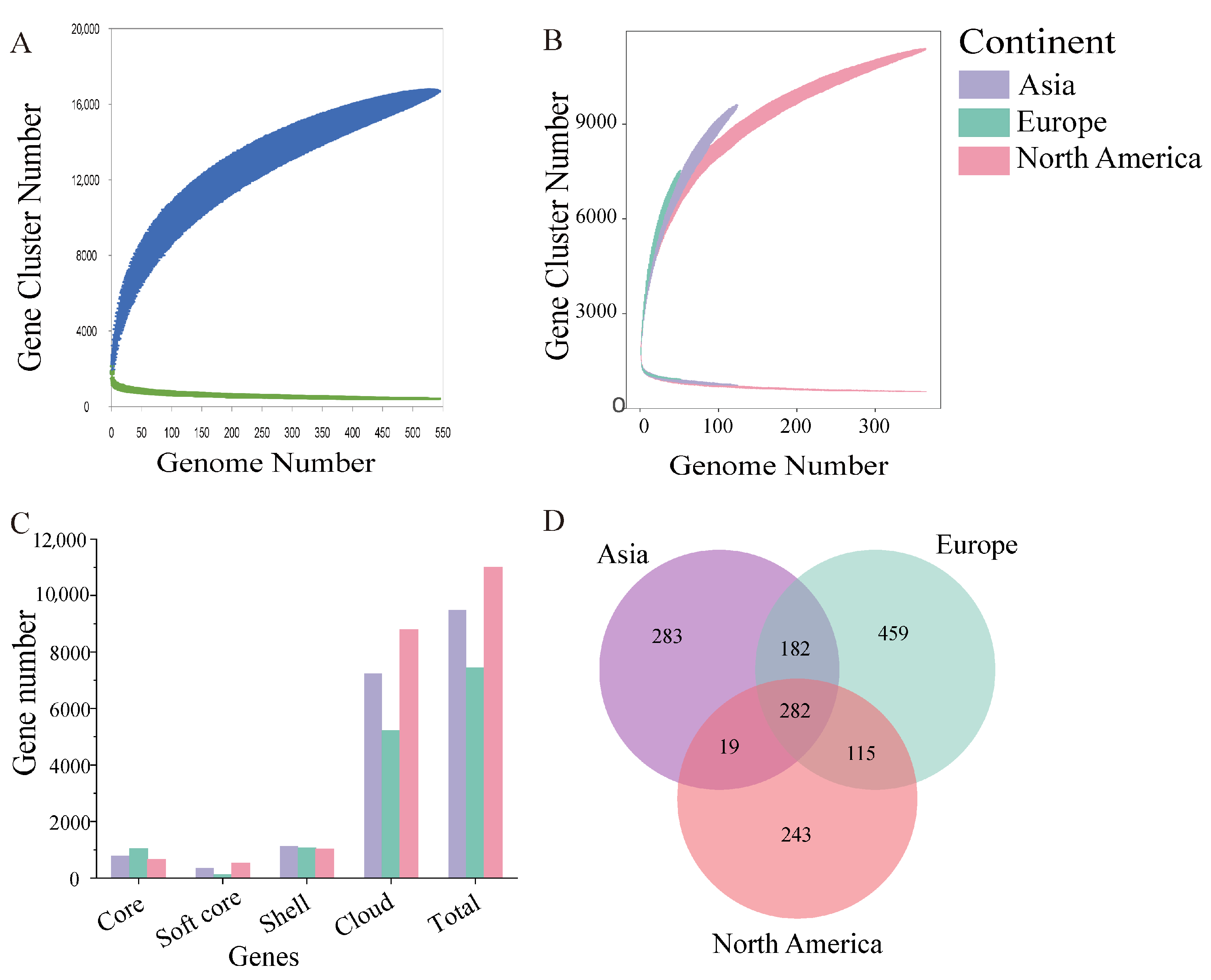
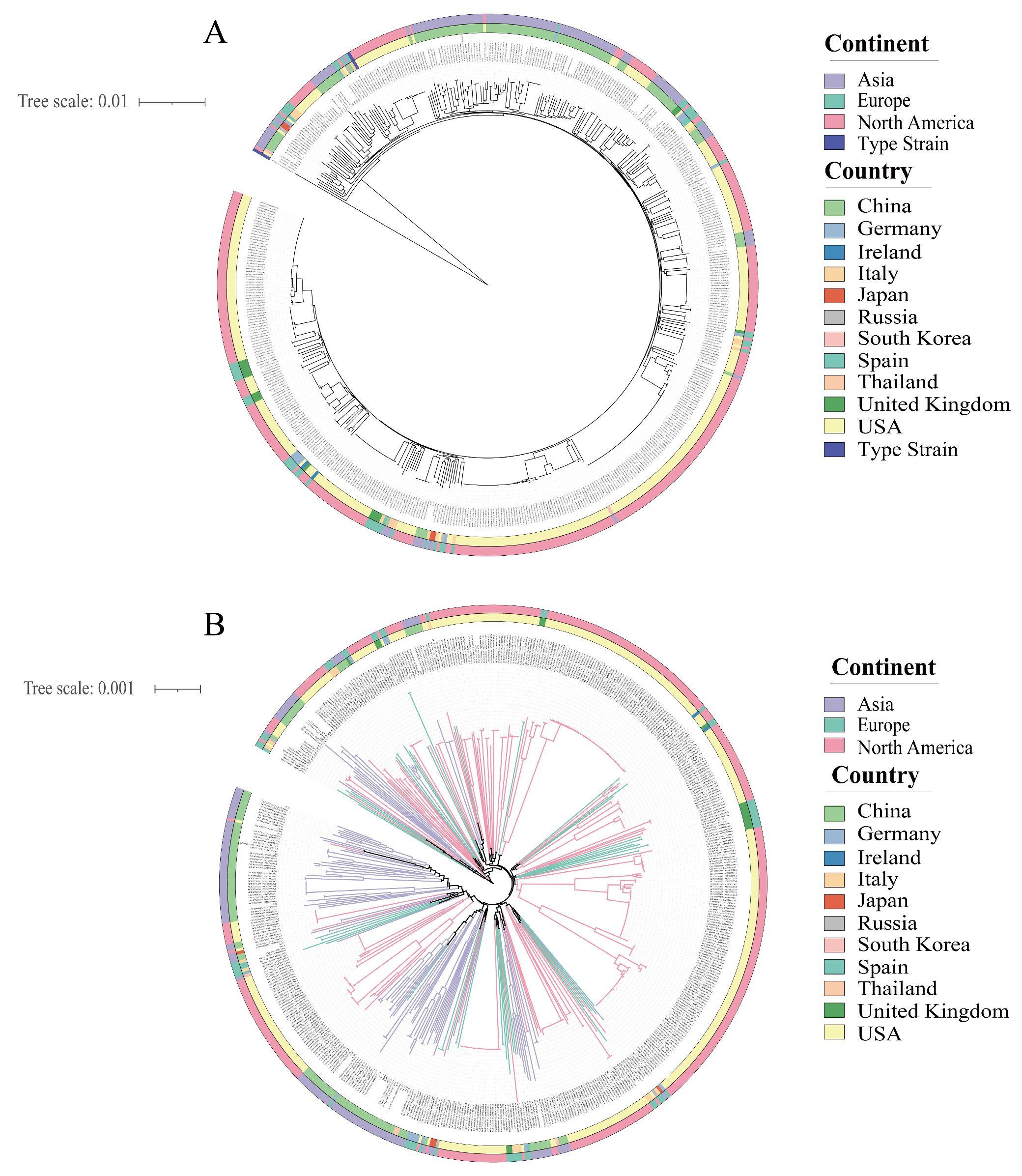


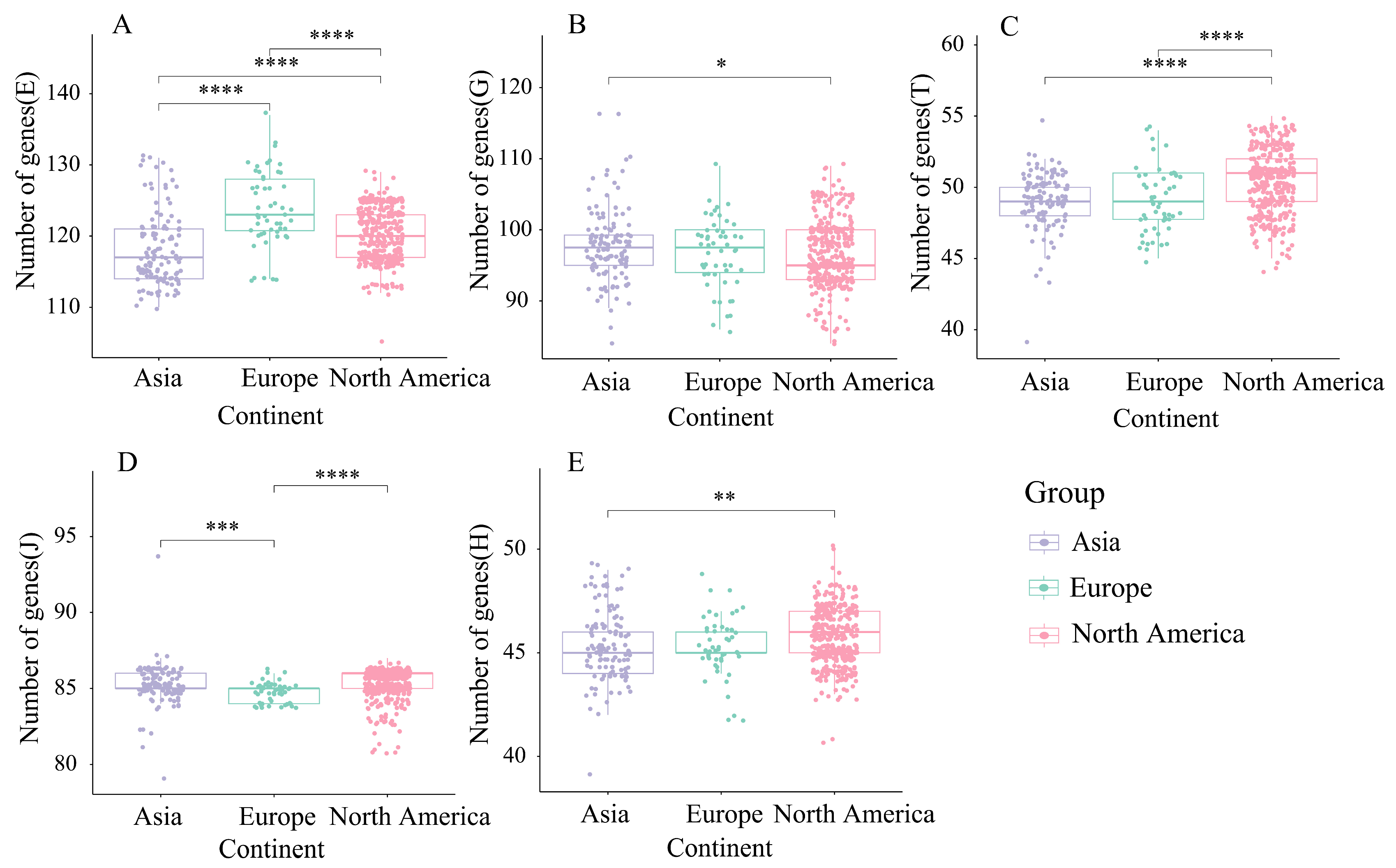
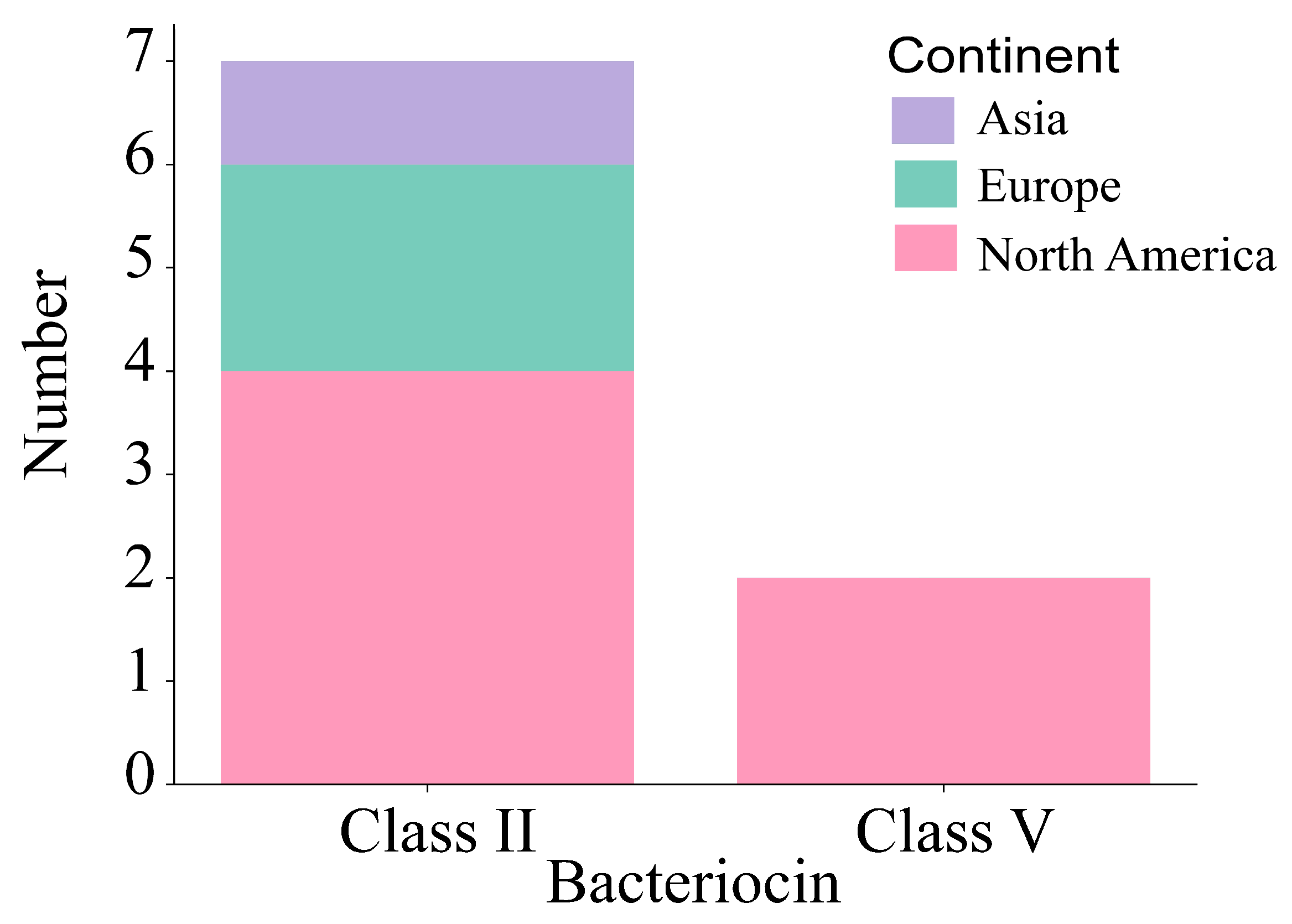
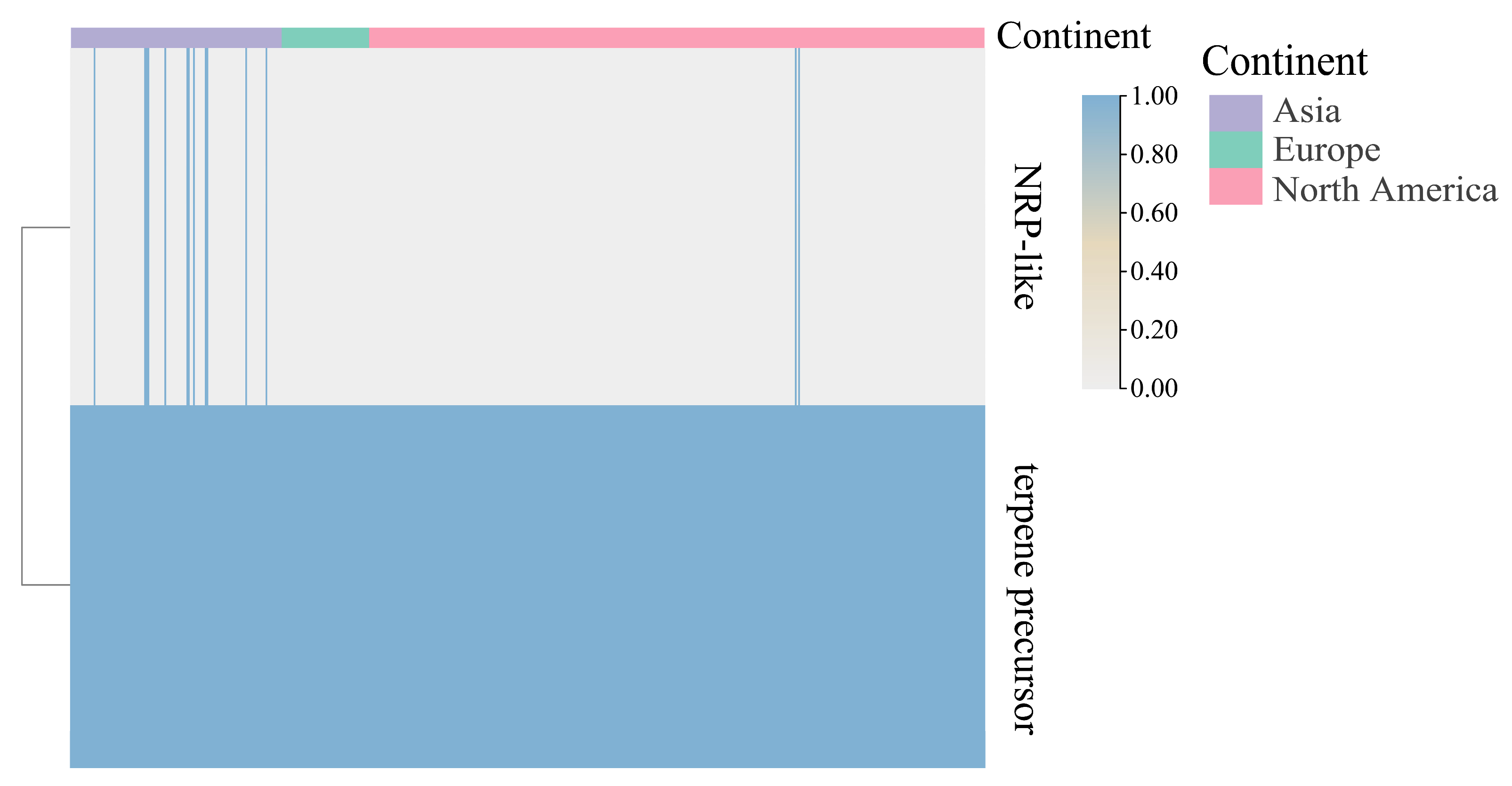

Disclaimer/Publisher’s Note: The statements, opinions and data contained in all publications are solely those of the individual author(s) and contributor(s) and not of MDPI and/or the editor(s). MDPI and/or the editor(s) disclaim responsibility for any injury to people or property resulting from any ideas, methods, instructions or products referred to in the content. |
© 2025 by the authors. Licensee MDPI, Basel, Switzerland. This article is an open access article distributed under the terms and conditions of the Creative Commons Attribution (CC BY) license (https://creativecommons.org/licenses/by/4.0/).
Share and Cite
Fu, P.; Qi, H.; Liu, W. Comparative Genomics and Adaptive Evolution of Bifidobacterium adolescentis in Geographically Distinct Human Gut Populations. Foods 2025, 14, 2747. https://doi.org/10.3390/foods14152747
Fu P, Qi H, Liu W. Comparative Genomics and Adaptive Evolution of Bifidobacterium adolescentis in Geographically Distinct Human Gut Populations. Foods. 2025; 14(15):2747. https://doi.org/10.3390/foods14152747
Chicago/Turabian StyleFu, Pei, Hao Qi, and Wenjun Liu. 2025. "Comparative Genomics and Adaptive Evolution of Bifidobacterium adolescentis in Geographically Distinct Human Gut Populations" Foods 14, no. 15: 2747. https://doi.org/10.3390/foods14152747
APA StyleFu, P., Qi, H., & Liu, W. (2025). Comparative Genomics and Adaptive Evolution of Bifidobacterium adolescentis in Geographically Distinct Human Gut Populations. Foods, 14(15), 2747. https://doi.org/10.3390/foods14152747





